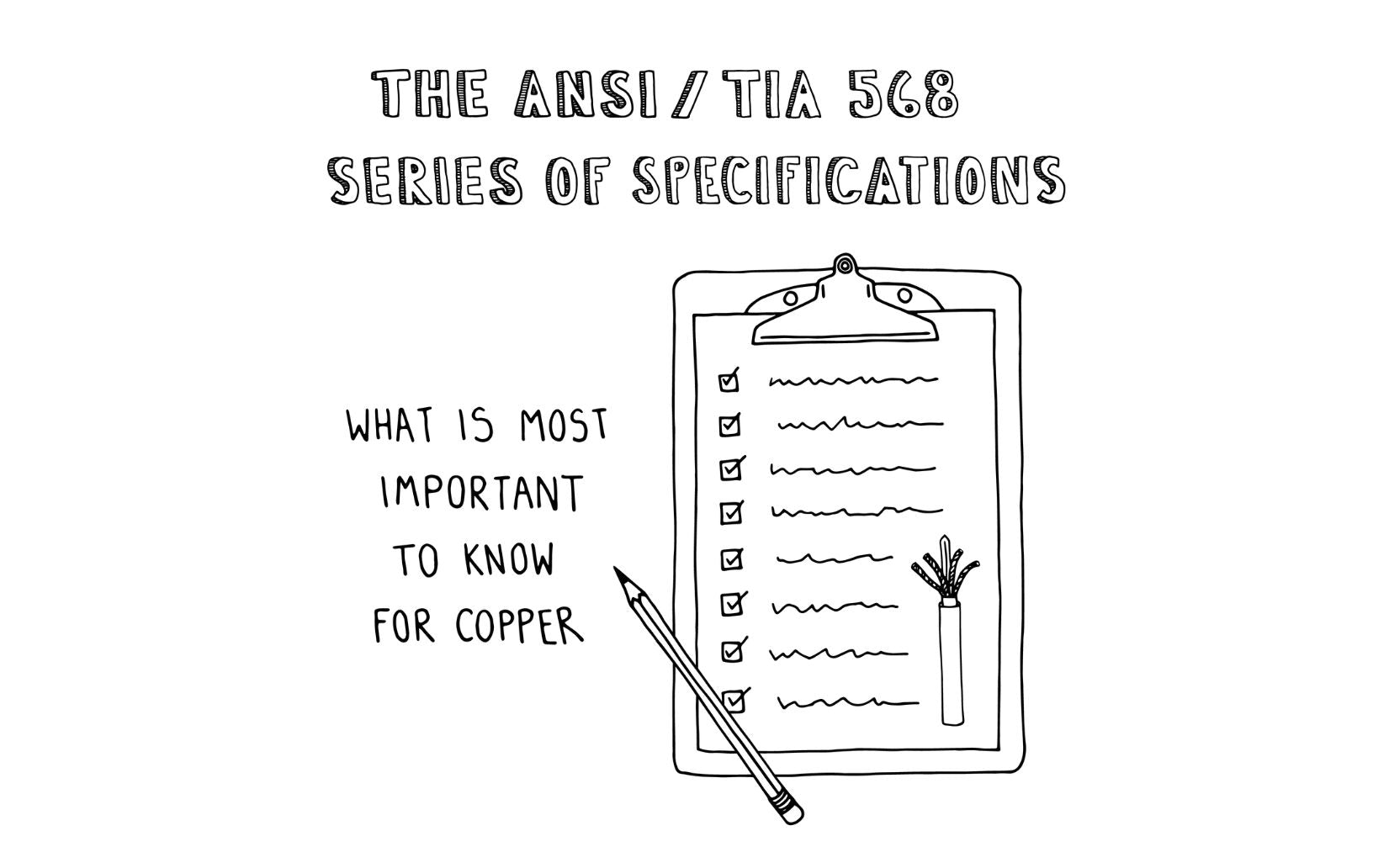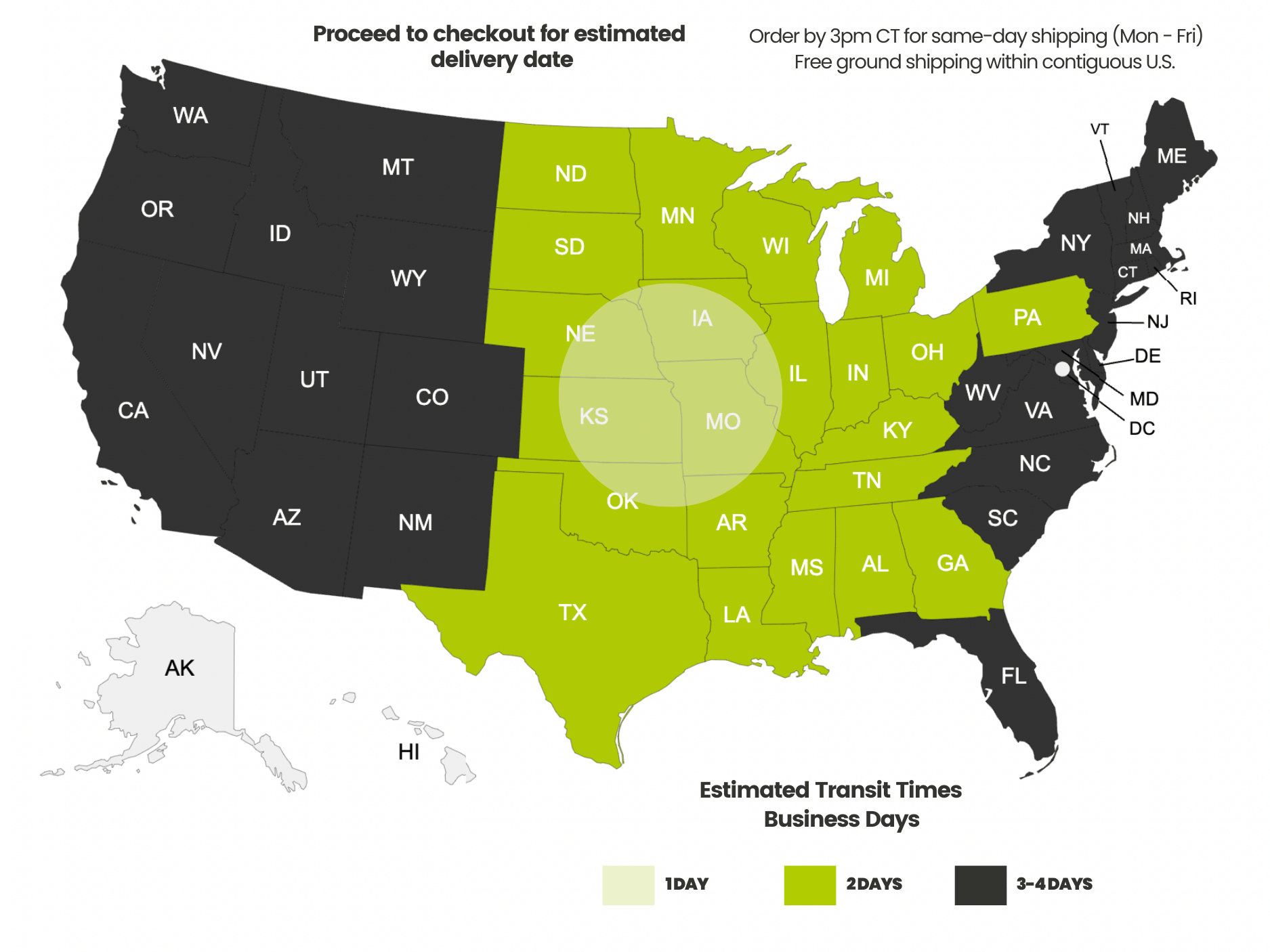Payment methods accepted

The ANSI/TIA 568 Series of Specifications: What is Most important to Know for Copper
Written by Don Schultz, trueCABLE Senior Technical Advisor, Fluke Networks Copper/Fiber CCTT, BICSI INST1, INSTC, INSTF Certified
What does ANSI/TIA mean?
No doubt you have noticed when shopping for your Ethernet network the usage of ANSI/TIA 568 C.2 Certified or verified. Is this some sort of marketing ploy? What does it mean? Who exactly is ANSI/TIA?
I poured over a large portion of the ANSI/TIA 568 series of standards (from C.0 through C.2) and noted exactly what the average person really needs to know about. Considering this set of documents is over 370 pages long, this was no small task.

Equally no small task was determining what was useful and what was esoteric. I apologize in advance to those who are looking for very detailed guidelines about how to construct a telecom room, as I won’t deep dive into those parts.
Sorry, no carpet allowed in the telecom room. You can have a drop ceiling in your server room, however.
I also won’t cover anything relating to fiber optic cable, as this will be reserved for a future article. The ANSI/TIA 568 C.3 section addresses fiber applications specifically.
Knowing guidelines exist is half the battle. If you wish to pick up a copy of these specifications, it won’t be cheap. You can expect to drop $1,000 to $1,600. Here is the link to the store to purchase: TIA Web Store, 568 Standards.
What is ANSI?
The American National Standards Institute (ANSI) is a non-profit organization leading many sub-organizations (not just telecommunications) composed of industry partners in the development of technical standards.

The Telecommunications Industry Association (TIA) is an ANSI accredited organization. The TIA TR42 Engineering Committee is the actual group of folks that develop the TIA 568 standards for telecommunications cabling infrastructure in commercial buildings, residential buildings, homes, data centers, and more. The standards are voluntary. So, TIA is not the “technical FDA” for example. There is no “TIA jail” to go to if you break all the rules.
Compliance is important, though, if you want to avoid chaos.
It does behoove you to understand some aspects of the standard as it gives you the edge in determining what information presented to you is correct, what marketing assertions are harmless, and what is flat out incorrect. I will try to highlight common myths and debunk them throughout this blog. My goal is to be transparent with you about something that usually falls into the marketing or harmless category.
Important things to know
Here's what is most important to know from the ANSI/TIA 568 C specs if you install Ethernet data cabling in the typical DIY scenario (home up to medium sized business).
Check Specifications
Check the Manufacturer's Specifications first before buying:
- You want your investment to work right. Make certain the manufacturer has documented the product complies with ANSI/TIA 568 C.2 or 2.D guidelines. Do not buy anything without stated compliance and give strong preference to products with published test results.
- Beware of products that do not have full regulatory compliance. A great example is Copper Clad Aluminum (CCA) cable. It may actually test out and comply with the TIA performance standards (at least, in the factory) but it does not comply with safety regulations. Why is this important? Read the blog about how you can seriously go wrong with CCA right here: Copper Clad Aluminum vs Copper: The Ultimate Test on a Fluke Versiv DSX Cable Analyzer.
Construction & Physical Performance Guidelines
Construction and physical performance rules for Ethernet Cable:

- Must have a continuous overall thermoplastic jacket (PVC for example).
- Must consist of eight conductors twisted into four colored pairs, as follows:
- Pair 1: White-blue twisted with Blue
- Pair 2: White-orange twisted with Orange
- Pair 3: White-green twisted with Green
- Pair 4: White-brown twisted with Brown
- Bulk horizontal (structure) cable may have a 22 AWG through 24 AWG conductor size.
- Work area cable (aka patch cable) may have a 26 AWG or 28 AWG conductor size.
- No single insulated conductor (copper plus insulation) may exceed 1.53 mm and should be kept to 1.22 mm or less for compatibility reasons.
- The maximum overall cable thickness, or jacket OD (outer diameter) may not exceed 9.0 mm.
- Ultimate breaking strength shall exceed 90 footpounds (NOT to be confused with installation pulling limits).
- The cable must withstand a bend of 4X the jacket OD for U/UTP (unshielded) cable or 8X the jacket OD for F/UTP or SF/UTP (overall shield cable) at -20° C without cracking the jacket or shielding (if applicable).
- Bulk horizontal cable (structure) must be marked with the transmission performance (like Category rating). Here is a great guide to that topic: Ethernet Cable Identification for Beginners.
- Cable may possess additional non-electrically conductive (called dielectric) wraps around the conductors (polyester tape or waterproof tape for example).
- If the cable is shielded, the shield must comply with surface impedance (resistance) standards for electrical conductivity. It also must be laminated foil with plastic construction and/or braided wire. In the case of laminated foil shield construction, at least one 26 AWG or thicker tin plated non-insulated copper conductor must make direct contact with the cable shield for use as an ESD ground (drain) wire. A cable can use both shield types, and the braided shield can double as the ESD ground (drain) as long as both shields are making direct contact.

The NEC does not allow for anything other than stranded or solid copper conductors in low voltage cabling. Installations using CCA are unsafe and potentially illegal.
And that is it for construction. What is notably absent? We don’t see anything about how tightly the pairs should be twisted or what kind of cable jacket should be used. Manufacturers have breathing room to construct the cable within these guidelines. What is unwritten is that although the cable may meet the rather loosely defined TIA 568 physical guidelines, it must also meet UL or ETL safety requirements and comply with the rules of the National Electric Code (NEC).
And this, folks, is why a manufacturer can legally make Copper Clad Aluminum cable and call it Ethernet and not end up in legal trouble. Where the flat-out false advertising starts is if the manufacturer claims the cable can be installed anywhere at all.
Big trouble starts when you, the installer, unknowingly installs unsafe cable types like CCA or the incorrect rated jacket into a commercial structure and violate any number of electrical and fire codes. Read more here about cable jacket ratings: Facts About Ethernet Cable Jacket Ratings.
Data Transmission Guidelines
There are quite a few pages in the standard which address, with detailed equations, how cabling must perform in order to meet a certain Category. These particular rules are hard and fast, with no room for interpretation or error. As of now, here are the TIA recognized cable types:

How do all of the calculations get done so that a manufacturer can print the correct Category rating on a cable? A device called a Certifier is used. Certifiers are expensive and may require training.
What about Cat6E?
As you can see, there is no such TIA specification for "Cat6E". In the case of trueCABLE, we really do test our Cat6 to 550 MHz. The jacket may be stamped "Cat6 Enhanced" on our older cable, but we updated our jacket labeling to drop the "enhanced". That said, we retained the MHz rating on the cable. trueCABLE, like some other manufacturers, over-builds the cable to maximize quality. Cat6 cable should perform under any normal environment to the ANSI/TI stated standard of 250 MHz. The main thing to watch out for here is not to assume that since it can reach 550 MHz you can create a makeshift Cat6A cable.
TIA Installation & Termination Guidelines
Here is where the “rubber meets the road.” If you pay close attention to any spot in this document, this is the place to do it. Some of these rules are written in stone and some fall into the “best practice” realm, but all should be followed.
- The amount of “untwist” allowed is 0.5 inch from the end of the cable jacket to the point of termination. This means when you untwist the conductor pairs down to the jacket end and terminate the cable onto a RJ45 plug or keystone jack, the maximum distance from the end of the last twist to where electrical connection is actually made with the conductor is 1/2 inch. This is the case for all Categories of cable you are likely to install, from Cat5e through Cat6A and even includes Cat8. For detailed information around proper termination methodology, check out: How to: Terminate an Unshielded Pass Through RJ45 Connector.

- When installing an Ethernet cable, the maximum bend allowed (bend radius) is 4X the OD of the cable jacket for U/UTP cable and 8X the OD of the cable jacket for F/UTP or SF/UTP shielded cable. This rule does not apply when the manufacturer has specified otherwise. In the case of trueCABLE, we use 4X the OD for U/UTP and 7X for F/UTP shielded cable. This blog article will detail more: Obey the Bend.
- When pulling an Ethernet cable off of a reel, through a duct, or just pulling it in general you should not exert more than 25 foot-pounds of force to avoid distortion of the individual pairs of the cable. This will hurt performance. Further, don’t uncoil cable directly from the spool. Use a spool holder and pull the cable off smoothly.
- The maximum length of an Ethernet cable is 328 feet. Now, this can be a bit confusing. Here are the sub-rules to this rule:
- The 328 foot rule is from an actively powered device to another actively powered device, including any patch cables used.
- Best practice is to keep structured cable to 295 feet and reserve the remaining distance allowance for patch panels in the equipment closet and work areas using patch cables.
- When using the structure to patch cable method, always ensure the patch cables are the same or higher Category rating than the structured cable.
- If the run is only using structured cable, and is terminated like a patch cable (male terminations on both ends), then yes, the distance maximum is 328 feet. This does not mean you can do this with keystone jacks. Keystone jacks require a patch cord to plug into them, and from there to a PC or other equipment.
- Keep excess Cat6 or higher cable stored in the telecom room or equipment closet in a figure-eight pattern to minimize potential electrical interference issues. If any excess cable is stored in the work area (area where people and computers are) then it should be above a drop ceiling or in a wall.
- The only recognized conductor color patterns for termination are according to T568A or T568B. You must use the same color scheme at both ends of the same cable segment. This blog and video helps define exactly what that means: T568a vs T568b.
- Velcro (hook and loop) ties are preferred to nylon zip ties. Nylon zip ties focus the force in a much smaller area and can impede cable performance. If nylon zip ties are used, they should be applied loosely. NEVER use metal staples to affix cabling.
- Don’t run cables over hot air ducts or hot water pipes. It is easy to exceed the proper operating temperature of the cable when doing this. Check out: Temperature's Effect on Ethernet Cable Length for information about maximum run length with various ambient temperatures.
- Avoid electrical wiring. Maintain your distance. This blog article will detail best practices when running Ethernet near electrical: Top 2 Things to Consider When Running Ethernet and Power.
- Shielded Ethernet cable must follow proper grounding requirements to avoid ground loops and floating cable shields. You can avoid this situation by referencing: How to Fix a Ground Loop. For additional information around shielded cable, check out: Shielded vs Unshielded Cable.
So, there you have it. This short distillation should not be confused for a substitute of the full ANSI/TIA 568 series (and other applicable) standards. These are the highlights of the installation rules and best practices which apply to the typical installer.
 The standard devotes many pages to organization and construction of everything from the main telecom room to satellite wiring closets. We only hit the most relevant items here.
The standard devotes many pages to organization and construction of everything from the main telecom room to satellite wiring closets. We only hit the most relevant items here.Revisions
One of the key items to realize about the standards is that they change. Often, it is minor details that won’t mean much to the average person. Sometimes there is a large change and it results in the publishing of a new set of standards. The latest set is actually now at “D” revision, published in 2018. Does this mean that the “C” stuff is irrelevant and wrong? Not at all. In the eyes of ANSI/TIA the “C” revision, which was published in 2009, is aged but not necessarily wrong.
"D" Revision Adds:
- Category 8 cabling and component requirements.
- 28 AWG patch cables and associated rules around using them.
- Guidelines have been established to recognize the connection of structured cable directly to a device with a RJ45 8P8C plug. This is known as a MPTL (Modular Plug Terminated Link).
- Guidelines for PoE (Power over Ethernet) installations are now reflective of higher wattage and smaller conductor cabling.
- Conductor insulation diameter has been increased from 1.53 mm to 1.64 mm.
- Testing methods in the laboratory and field are detailed for Category 8 cabling and components.
- Guidelines for cables installed in higher temperature environments are provided.
So, not much changed. Certainly no changes that would worry someone who is installing Cat6 or Cat6A cabling in the average small business or home. The new big thing, of course, is the addition of Cat8 copper twisted pair cabling and how to test it. Cat8 cabling is meant for 25GBASE-T or 40GBASE-T networking speeds in the data center.
Additionally, reputable manufacturers of cabling and accessories will take note of any changes and incorporate them into what you buy. So, take a deep breath as the manufacturers have done the vast majority of the homework for you. After all, that is what you are paying for and why there is a bullet point about compliance in their advertising.
As always, Happy Networking!
trueCABLE presents the information on our website, including the “Cable Academy” blog and live chat support, as a service to our customers and other visitors to our website subject to our website terms and conditions. While the information on this website is about data networking and electrical issues, it is not professional advice and any reliance on such material is at your own risk.



























